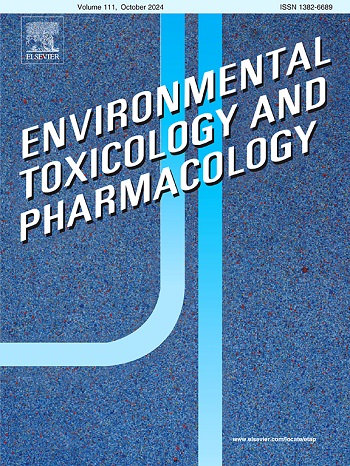氯菊酯暴露通过负向调节自噬和Wnt/β-catenin通路增加间充质干细胞的成脂承诺
IF 4.2
3区 环境科学与生态学
Q2 ENVIRONMENTAL SCIENCES
引用次数: 0
摘要
氯菊酯(PER)是一种用于农业环境和公共卫生的合成拟除虫菊酯。以前,PER暴露与脂肪生成增加有关。Wnt/β-catenin通路也与间充质干细胞(MSCs)的成脂分化调控有关。本研究评估了急性PER暴露(24 hr)对Wnt/β-catenin通路的影响及其对MSC成脂承诺的影响。它还评估了Wnt/β-catenin信号传导和自噬在per介导的脂肪形成中的相互作用。免疫印迹结果显示,PER抑制Wnt/β-catenin信号传导。尼罗红染色显示,与单独使用PER相比,PER与氯化锂联合预处理后的脂肪生成减少。此外,免疫印迹显示氯化锂介导的MSCs自噬激活。尼罗红染色显示Wnt/β-catenin通路激活和自噬抑制了成脂分化。总体而言,数据显示自噬和Wnt/β-catenin通路的交叉对话负向调节MSCs的成脂承诺。本文章由计算机程序翻译,如有差异,请以英文原文为准。
Permethrin exposure increases the adipogenic commitment of mesenchymal stem cells by negatively regulating autophagy and the Wnt/β-catenin pathway
Permethrin (PER) is a synthetic pyrethroid used in agricultural settings and public health. Previously, PER exposure has been linked with increased adipogenesis. The Wnt/β-catenin pathway is also associated with the regulation of adipogenic differentiation of mesenchymal stem cells (MSCs). This study evaluated the effect of acute PER exposure (24 hr) on the Wnt/β-catenin pathway and its impact on adipogenic commitment of MSC. It also assessed the cross-talk of Wnt/β-catenin signaling and autophagy in PER-mediated adipogenesis. Immunoblotting results showed PER inhibited the Wnt/β-catenin signaling. Nile red staining showed decreased adipogenesis upon PER pre-treatment in combination with lithium chloride compared to PER alone. Further, immunoblotting revealed lithium chloride-mediated activation of autophagy in MSCs. Nile red staining showed inhibition of adipogenic differentiation upon activation of the Wnt/β-catenin pathway and autophagy. Overall, the data showed that cross-talk of autophagy and the Wnt/β-catenin pathway negatively regulates adipogenic commitment of MSCs.
求助全文
通过发布文献求助,成功后即可免费获取论文全文。
去求助
来源期刊
CiteScore
7.00
自引率
4.70%
发文量
185
审稿时长
34 days
期刊介绍:
Environmental Toxicology and Pharmacology publishes the results of studies concerning toxic and pharmacological effects of (human and veterinary) drugs and of environmental contaminants in animals and man.
Areas of special interest are: molecular mechanisms of toxicity, biotransformation and toxicokinetics (including toxicokinetic modelling), molecular, biochemical and physiological mechanisms explaining differences in sensitivity between species and individuals, the characterisation of pathophysiological models and mechanisms involved in the development of effects and the identification of biological markers that can be used to study exposure and effects in man and animals.
In addition to full length papers, short communications, full-length reviews and mini-reviews, Environmental Toxicology and Pharmacology will publish in depth assessments of special problem areas. The latter publications may exceed the length of a full length paper three to fourfold. A basic requirement is that the assessments are made under the auspices of international groups of leading experts in the fields concerned. The information examined may either consist of data that were already published, or of new data that were obtained within the framework of collaborative research programmes. Provision is also made for the acceptance of minireviews on (classes of) compounds, toxicities or mechanisms, debating recent advances in rapidly developing fields that fall within the scope of the journal.

 求助内容:
求助内容: 应助结果提醒方式:
应助结果提醒方式:


